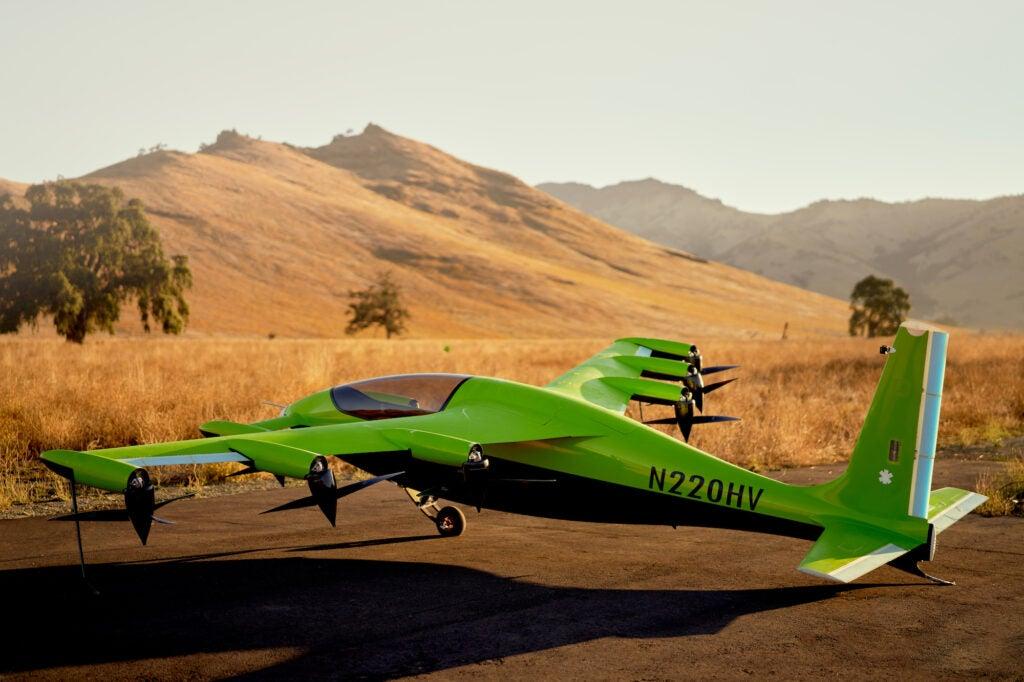Kitty Hawk’s electric airplane will fly you around—with no pilot
Check out Heaviside, an air taxi designed to someday transport just one brave soul from point A to B.
ByRob Verger| Updated Sep 23, 2021 3:00 PM
Heaviside is an electric aircraft that holds just one person and flies itself.Kitty HawkSHAREA number of companies are trying to make electric airborne Ubers happen: aircrafts that can take off and land vertically, carrying smartphone-clutching customers from one point to another. A firm called Joby, for example, makes an aircraft that will hold four people, plus a pilot. Another is Kitty Hawk, which is flying a craft they’ve dubbed Heaviside.
A name like Heaviside evokes images of a very large, or heavy, aircraft, like a Boeing 747. But this little electric flying machine is designed to hold exactly one person, and someday—if the company’s plans come to fruition—that person could be you, even if you’re not a pilot. In fact, the whole point of the aircraft is that it’s intended to autonomously transport one regular person with no special knowledge of aviation to wherever they want to go.
Sebastian Thrun, Kitty Hawk’s CEO and a pilot, jokes about this point in a recent interview with PopSci. “Watching myself fly, it’s become so clear, there should be no pilot in the cockpit,” he says.
The Heaviside aircraft—it’s named for Oliver Heaviside, a deceased British mathematician—measures 23 by 18 feet and needs a 900-square-foot landing zone. It sports eight electric motors in total, which can tilt to allow the plane to take off and land vertically. It can fly a distance of 100 miles without running out of battery power and can hit speeds of 180 mph, but would go slower when trying to travel as far as possible to conserve energy.
The craft could play a role in a future that’s like “Jetsons meets Uber,” says Thrun, which is a common vision in the burgeoning electric flying taxi industry. The goal behind craft like these is not for individuals to own them, but for companies to operate them. “Right now, we’re flying Heaviside autonomously three times a week,” he says.
[Related: The post-9/11 flight security changes you don’t see]

For a passenger who wants to someday book passage in an aircraft like Heaviside, they’d do so through an app. That’s a typical model for how electric air taxis would work, but what’s interesting about Heaviside and Kitty Hawk is that it would be a flying Uber for just one person. Joby’s aircraft holds four passengers and a pilot. Another from Archer—which has not flown yet—is designed to hold two for now. And an autonomous vehicle made by Wisk, called Cora, holds two passengers. (Wisk is a joint venture between Kitty Hawk and Boeing, and Thrun is on the board; Wisk and Archer are also engaged in a legal dispute.)
That raises the question: Will a person feel comfortable climbing in a small, autonomous electric aircraft solo? “We don’t know,” Thrun says, but cites the fact that humans have become used to other forms of potentially frightening technology, from elevators to the type of uncrewed trains that carry people from terminal to terminal at airports. He expects the interface for the passenger to be minimal, but will include a way to deploy an emergency ballistic parachute that can lower the entire plane to the ground. As for the seat itself, in June The New York Times described it as “tight fit, even for the average-sized person.” Bloomberg reported earlier this month that Thrun himself plans to be the first passenger.
“What’s really important to us is that the passenger on board has the possibility to talk to somebody,” Thrun says, meaning they could be in touch with someone on the ground if needed, although whether that happens via a video chat function or voice connection is currently up in the air.
As for safety, one of the promises of aircraft like this is that because they have multiple electric motors and propellers, they offer more redundancy in their designs than, say, a helicopter. Thanks to the fact that Heaviside has eight motors, “we can easily afford losing one,” Thrun says, “and then still continue our flight as if nothing happened.”
“We [don’t have] a single non-redundant point of failure, other than the airframe itself,” he adds. Besides the parachute, other safety features include having the aircraft remotely commanded to return back to where it departed from if needed, or directed to a pre-chosen emergency landing spot that’s clear of obstacles like power lines. He also says they’re installing a laser on the aircraft that would allow it to survey the ground below to ensure the aircraft isn’t, say, landing on a human being.
[Related: I flew in an F-16 with the Air Force and oh boy did it go poorly]
A self-flying airplane is something akin to a self-driving car, and Thrun sees this air-taxi service as “very similar to Waymo on the ground,” referring to the Alphabet-owned autonomous car company. (Thrun was a founder of that project at Google before it became Waymo.) In fact, perhaps counterintuitively, Thrun argues that the pursuit of automation in aviation is easier than the same task on the ground, where streets are busy. “There are some nuances,” he says, “but in terms of the work it takes to fly autonomously in the air, it’s like a small fraction of the work it takes to drive a car on the ground.”
One of the benefits of pursuing autonomy in the air is that, of course, it’s a pretty uncluttered environment compared to hectic roads below. Part of what makes the aviation problem harder, though, includes factors like weather and aircraft icing, as well as the fact that the stakes are always higher in the sky. “The only thing that makes the airplane harder is if you really have a deep problem, the threat to human health and life could be much more severe than in the car,” he says. You can pull a car over by the side of the road, but not an airplane.
Finally, one other concern, besides factors like safety, passenger trust, and the ride quality and experience of actually being in a small aircraft by yourself, is how regulators will handle the idea of an autonomous aircraft that carries a passenger. “While the FAA is incredibly cooperative,” he says, “they have not yet figured out what the right rules for this [are], so it’s going to take a few years to get there.”
Correction on Jan. 25, 2022: This article has been updated to clarify that Wisk’s autonomous Cora vehicle holds two passengers, not one person and one pilot; it has no pilot.
Rob VergerRob Verger is the Technology Editor at Popular Science, where he leads a team of journalists who cover everything from artificial intelligence, cryptocurrency, and cybersecurity to privacy, security, and the military. Contact the author here.
air taxis autonomous aircraft Aviation boeing electric aircraft







